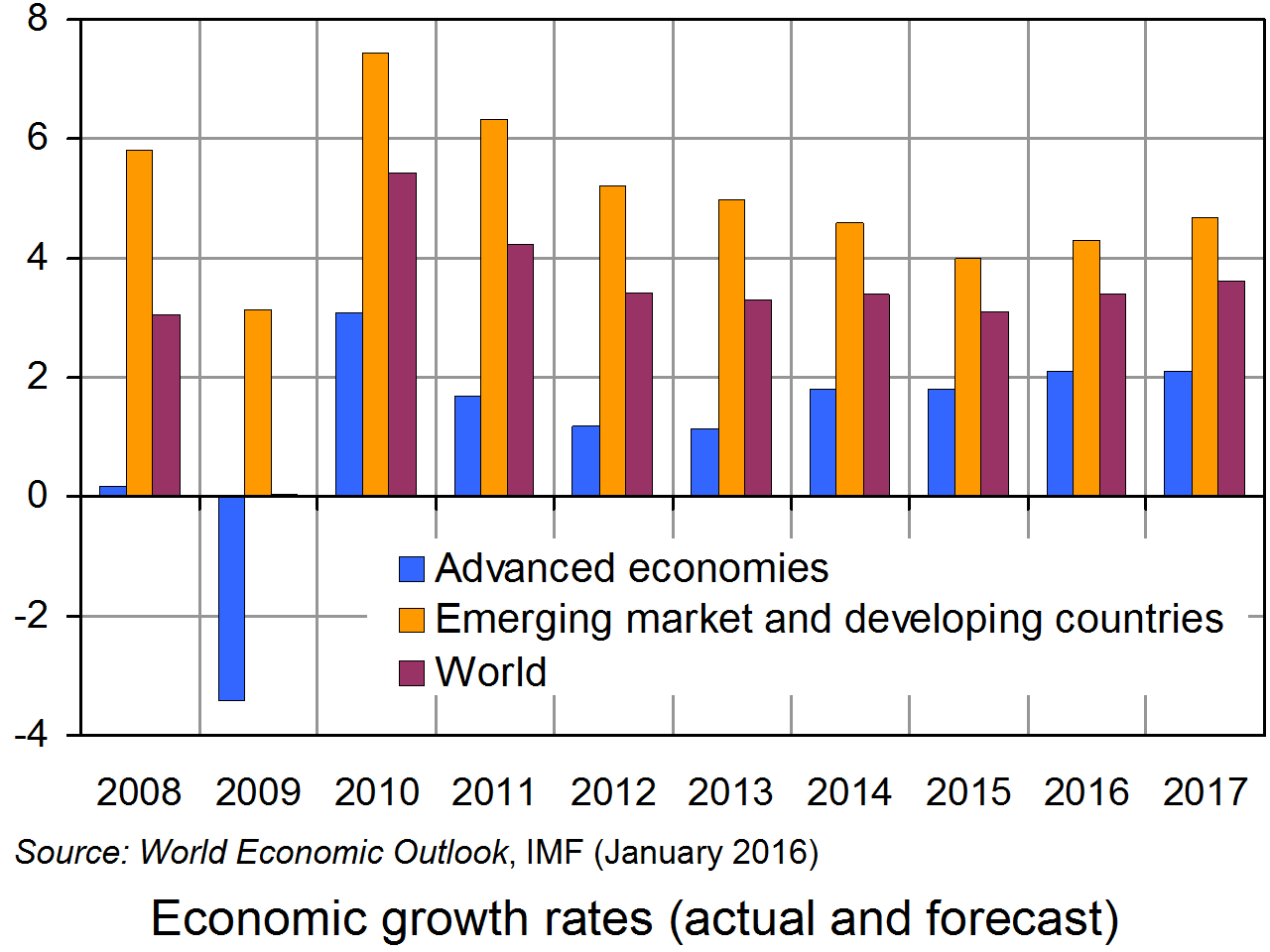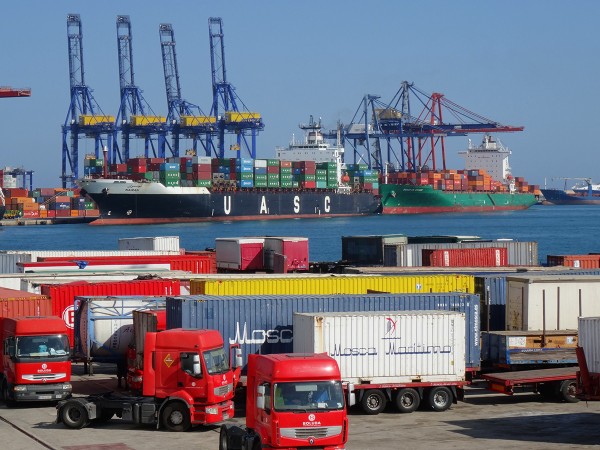 There is a lot of pessimism around about the state of the global economy and the prospects for more sustained growth. Stock markets have been turbulent; oil and other commodity prices have fallen; inflation has been below central bank targets in most countries; and growth has declined in many countries, most worryingly in China.
There is a lot of pessimism around about the state of the global economy and the prospects for more sustained growth. Stock markets have been turbulent; oil and other commodity prices have fallen; inflation has been below central bank targets in most countries; and growth has declined in many countries, most worryingly in China.
The latest worry, expressed by finance ministers at the G20 conference in Shanghai, is that UK exit from the EU could have a negative impact on economic growth, not just for the UK, but for the global economy generally.
But is this pessimism justified? In an interesting article in the Independent, Hamish McRae argues that there are five signs that the world economy is not doomed yet! These are:
|
|
| • |
There are more monetary and fiscal measures that can still be taken to boost aggregate demand. |
| • |
Despite some slowing of economic growth, there is no sign of a global recession in the offing. |
|
|
| • |
US and UK growth are relatively buoyant, with consumer demand ‘driving the economy forward’. |
| • |
Deflation worries are too great, especially when lower prices are caused by lower commodity prices. These lower costs should act to stimulate demand as consumers have more real purchasing power. |
| • |
Inflation may start to edge upwards over the coming months and this will help to increase confidence as it will be taken as a sign that demand is recovering. |
So, according to McRae, there are five things we should look for to check on whether the global economy is recovering. He itemises these at the end of the article. But are these the only things we should look for?
Five signs that the world economy is not doomed yet Independent, Hamish McRae (27/2/15)
Questions
- What reasons are there to think that the world will grow more strongly in 2016 than in 2015?
- What reasons are there to think that the world will grow less strongly in 2016 than in 2015?
- Distinguish between leading and lagging indicators of economic growth.
- Do you agree with McRae’s choice of five indicators of whether the world economy is likely to grow more strongly?
- What indicators would you add to his list?
- Give some examples of ‘economic shocks’ that could upset predictions of economic growth rates. Explain their effect.
 Interest rates in the UK have been at a record low since 2009, recorded at just 0.5%. In July, the forward guidance from Mark Carney seemed to indicate that a rate rise would be likely towards the start of 2016. However, with the recovery of the British economy slowing, together with continuing problems in Europe and slowdowns in China, a rate rise has become less likely. Forward guidance hasn’t been particularly ‘guiding’, as a rate rise now seems most likely well into 2016 or even in 2017 and this is still very speculative.
Interest rates in the UK have been at a record low since 2009, recorded at just 0.5%. In July, the forward guidance from Mark Carney seemed to indicate that a rate rise would be likely towards the start of 2016. However, with the recovery of the British economy slowing, together with continuing problems in Europe and slowdowns in China, a rate rise has become less likely. Forward guidance hasn’t been particularly ‘guiding’, as a rate rise now seems most likely well into 2016 or even in 2017 and this is still very speculative.
Interest rates are a key tool of monetary policy and one of the government’s demand management policies. Low interest rates have remained in the UK as a means of stimulating economic growth, via influencing aggregate demand. Interest rates affect many of the components of aggregate demand, such as consumption – through affecting the incentive to save and spend and by affecting mortgage rates and disposable income. They affect investment by influencing the cost of borrowing and net exports through changing the exchange rate and hence the competitiveness of exports.
Low interest rates therefore help to boost all components of aggregate demand and this then should stimulate economic growth. While they have helped to do their job, circumstances across the global economy have acted in the opposite direction and so their effectiveness has been reduced.
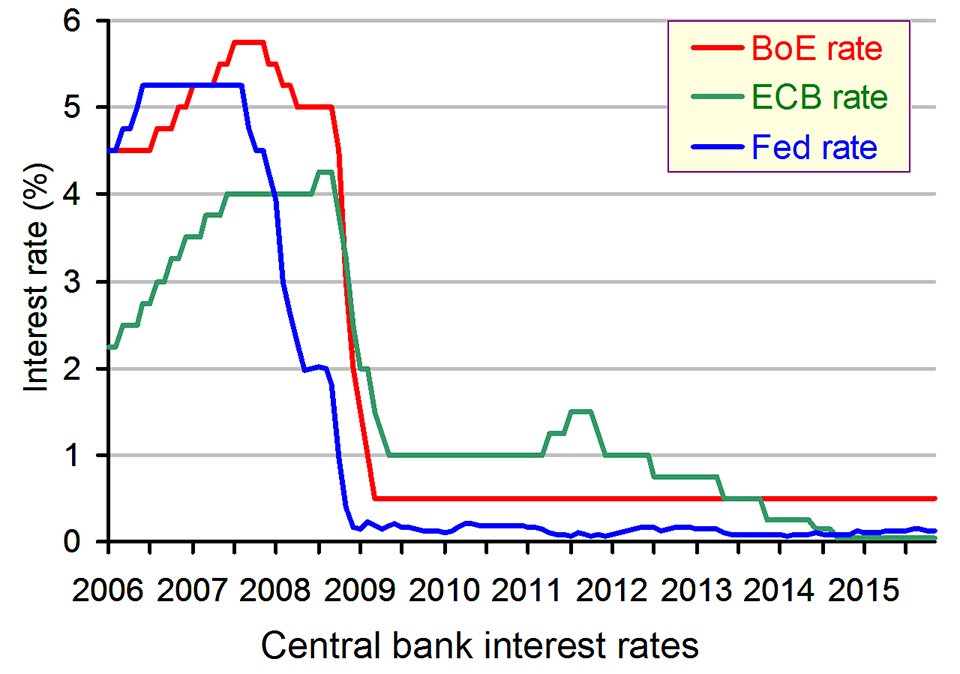 Although the latest news on interest rates may suggest some worrying times for the UK, the information contained in the Bank of England’s Inflation Report isn’t all bad. Despite its predictions that the growth rate of the world economy will slow and inflation will remain weak, the predictions from August remain largely the same. The suggestion that interest rates will remain at 0.5% and that any increases are likely to be at a slow pace will flatten the yield curve, and, with predictions that inflation will remain weak, there will be few concerns that continuing low rates will cause inflationary pressures in the coming months. Mark Carney said:
Although the latest news on interest rates may suggest some worrying times for the UK, the information contained in the Bank of England’s Inflation Report isn’t all bad. Despite its predictions that the growth rate of the world economy will slow and inflation will remain weak, the predictions from August remain largely the same. The suggestion that interest rates will remain at 0.5% and that any increases are likely to be at a slow pace will flatten the yield curve, and, with predictions that inflation will remain weak, there will be few concerns that continuing low rates will cause inflationary pressures in the coming months. Mark Carney said:
“The lower path for Bank Rate implied by market yields would provide more than adequate support to domestic demand to bring inflation to target even in the face of global weakness.”
However, there are many critics of keeping interest rates down, both in the UK and the USA, in particular because of the implications for asset prices, in particular the housing market and for the growth in borrowing and hence credit debt. The Institute of Directors Chief Economist, James Sproute said:
“There is genuine apprehension over asset prices, the misallocation of capital and consumer debt…Borrowing is comfortably below the unsustainable pre-crisis levels, but with debt once against rising there is a need for vigilance…The question is, will the Bank look back on this unprecedented period of extraordinary monetary policy and wish they had acted sooner? The path of inaction may seem easier today, but maintaining rates this low, for this long, could prove a much riskier decision tomorrow.”
hanges in the strength of the global economy will certainly have a role to play in forming the opinions of the Monetary Policy Committee and it will also be a key event when the Federal Reserve pushes up its interest rates. This is certainly an area to keep watching, as it’s not a question of if rates will rise, but when.
Articles
Bank of England dampens prospects of early UK rate rise BBC News (5/11/15)
Bank of England Governor gets his forward guidance on interest rates wrong Independent, Ben Chu (6/11/15)
Interest rates set to remain at rock-bottom right through 2016 as Bank of England cuts UK growth and inflation forecasts This is Money, Adrian Lowery (5/11/15)
 Pound slides as Bank of England suggests interest rates will stay low for longer – as it happened 5 November 2015 The Telegraph, Peter Spence (5/11/15)
Pound slides as Bank of England suggests interest rates will stay low for longer – as it happened 5 November 2015 The Telegraph, Peter Spence (5/11/15)
UK’s record low interest rates should be raised next Februrary says NIESE The Telegraph, Szu Ping Chan (4/11/15)
Fresh signs of slowdown will force interest rates rise to be put on hold The Guardian, Katie Allen (2/11/15)
The perils of keeping interest rates so low The Telegraph, Andrew Sentence (6/11/15)
Time to ask why we are still in the era of ultra-low rates Financial Times, Chris Giles (4/11/15)
No interest rate rise until 2017: Joy for homeowners as Bank of England delays hike in mortgage costs again Mail Online, Matt Chorley (5/11/15)
 Pound tumbles after Carney warns its strength threatens recovery Bloomberg, Lucy Meakin (5/11/15)
Pound tumbles after Carney warns its strength threatens recovery Bloomberg, Lucy Meakin (5/11/15)
Is Carney hurt by wrong rate steer? BBC News, Robert Peston (5/11/15)
Data and Reports
Inflation Report Bank of England (August 2015)
Inflation Report Bank of England (November 2015)
Historical Fan Chart Data Bank of England (2015)
Questions
- Use and AD/AS diagram, explain how low interest rates affect the key components of aggregate demand and in turn how this will affect economic growth.
- What is meant by the ‘yield curve’? How has it been affected by the latest release from the Monetary Policy Committee?
- Why has the value of the pound been affected following the decision to keep interest rates at 0.5%?
- How has the sterling exchange rate changed and how might this affect UK exports?
- What are the main concerns expressed by those who think that there is a danger from keeping interest rates low for too long?
- Why is the outlook of the global economy so important for the direction of interest rate changes?
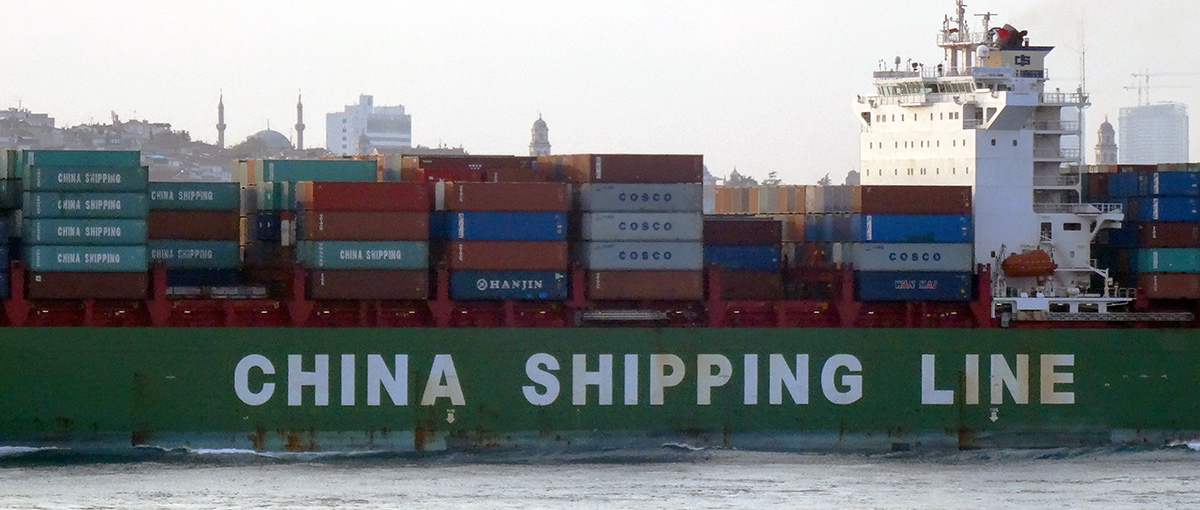 In two posts recently, we considered the pessimistic views of Robert Peston about the prospects for the global economy (see Cloudy skies ahead? and The end of growth in the West?). In this post we consider the views of Christine Lagarde, Managing Director of the International Monetary Fund, and Lord Adair Turner, the former head of the Financial Services Authority (FSA) (which was replaced in 2013 by the Financial Conduct Authority and the Prudential Regulation Authority).
In two posts recently, we considered the pessimistic views of Robert Peston about the prospects for the global economy (see Cloudy skies ahead? and The end of growth in the West?). In this post we consider the views of Christine Lagarde, Managing Director of the International Monetary Fund, and Lord Adair Turner, the former head of the Financial Services Authority (FSA) (which was replaced in 2013 by the Financial Conduct Authority and the Prudential Regulation Authority).
Christine Lagarde was addressing an audience at Georgetown University in Washington DC. The first four links below are to webcasts of the full speech and subsequent interviews about the speech. 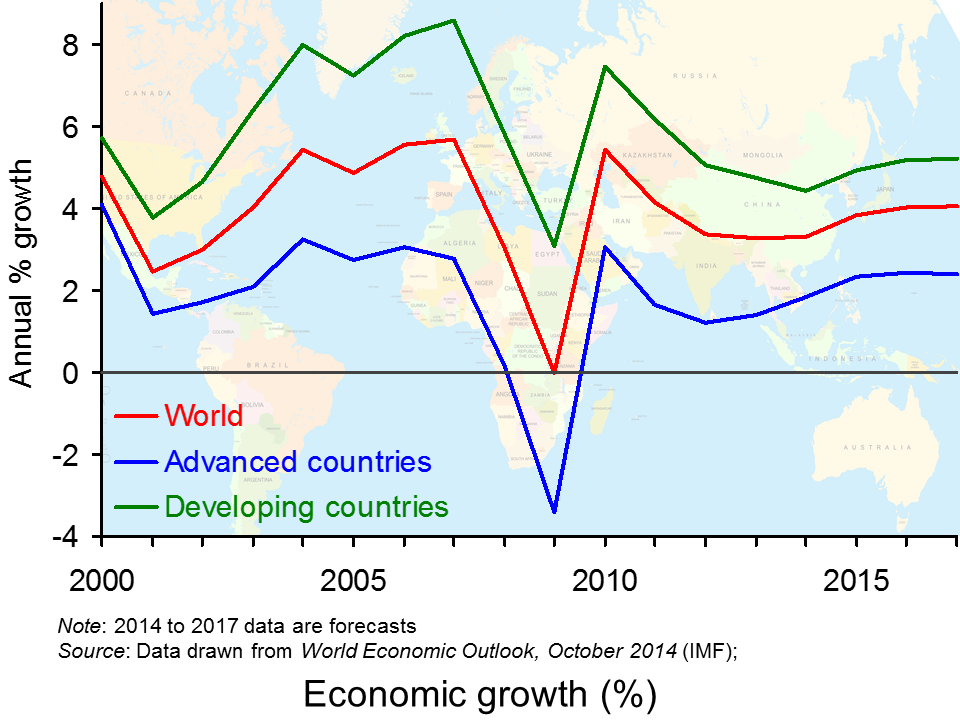 She gives a more gloomy assessment of the global economy than six months ago, especially the eurozone economy and several emerging economies, such as China. There are short- to medium-term dangers for the world economy from political conflicts, such as that between Russia and the West over Ukraine. But there are long-term dangers too. These come from the effects of subdued private investment and low infrastructure spending by governments.
She gives a more gloomy assessment of the global economy than six months ago, especially the eurozone economy and several emerging economies, such as China. There are short- to medium-term dangers for the world economy from political conflicts, such as that between Russia and the West over Ukraine. But there are long-term dangers too. These come from the effects of subdued private investment and low infrastructure spending by governments.
Her views are backed up by the six-monthly World Economic Outlook, published by the IMF on 7 October. There are links below to two webcasts from the IMF discussing the report and the accompanying datasets.
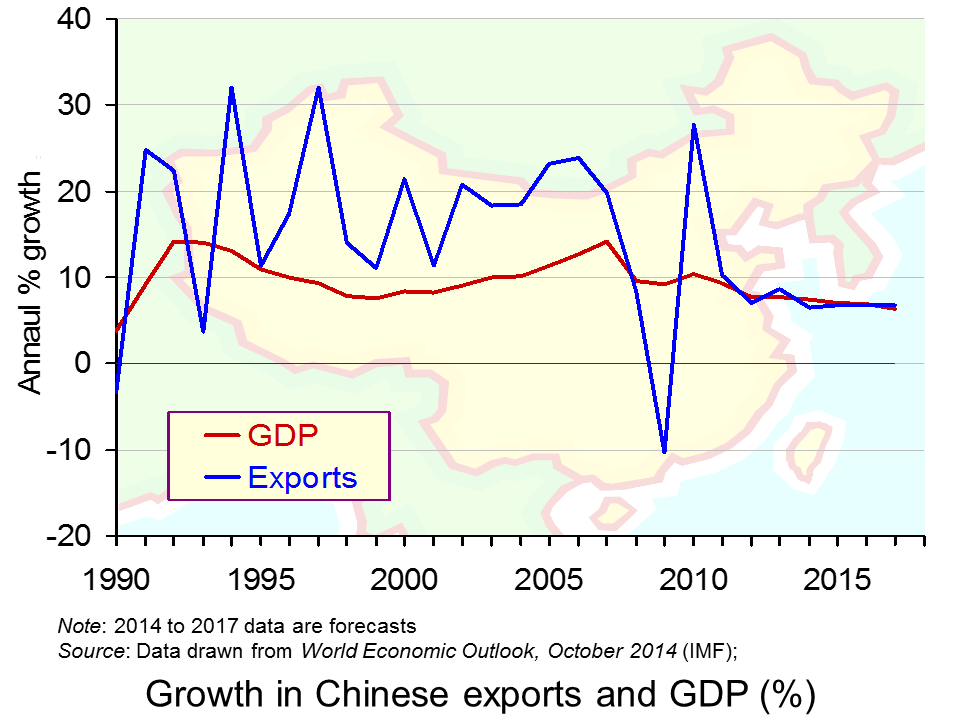 In the final webcast link below, Lord Turner argues that there is a “real danger of a simultaneous slowdown producing a big setback to growth expectations.” He is particularly worried about China, which is experiencing an asset price bubble and slowing economic growth. Other emerging economies too are suffering from slowing growth. This poses real problems for developed countries, such as Germany, which are heavily reliant on their export sector.
In the final webcast link below, Lord Turner argues that there is a “real danger of a simultaneous slowdown producing a big setback to growth expectations.” He is particularly worried about China, which is experiencing an asset price bubble and slowing economic growth. Other emerging economies too are suffering from slowing growth. This poses real problems for developed countries, such as Germany, which are heavily reliant on their export sector.
Webcasts
 The Challenges Facing the Global Economy: New Momentum to Overcome a New Mediocre IMF Videos, Christine Lagarde (full speech) (2/10/14)
The Challenges Facing the Global Economy: New Momentum to Overcome a New Mediocre IMF Videos, Christine Lagarde (full speech) (2/10/14)
 Christine Lagarde downbeat on global economy BBC News Canada, Christine Lagarde interviewed by Katy Kay (2/10/14)
Christine Lagarde downbeat on global economy BBC News Canada, Christine Lagarde interviewed by Katy Kay (2/10/14)
 IMF’s Lagarde on Global Economy, Central Banks Bloomberg TV, Christine Lagarde interviewed by Tom Keene (2/10/14)
IMF’s Lagarde on Global Economy, Central Banks Bloomberg TV, Christine Lagarde interviewed by Tom Keene (2/10/14)
 Lagarde: Global economy weaker than envisioned 6 months ago, IMF to cut growth outlook CNBC (2/10/14)
Lagarde: Global economy weaker than envisioned 6 months ago, IMF to cut growth outlook CNBC (2/10/14)
 IMF Says Uneven Global Growth Disappoints IMF Videos, Olivier Blanchard (7/10/14)
IMF Says Uneven Global Growth Disappoints IMF Videos, Olivier Blanchard (7/10/14)
 Time Is Right for an Infrastructure Push IMF Videos, Abdul Ablad (30/9/14)
Time Is Right for an Infrastructure Push IMF Videos, Abdul Ablad (30/9/14)
 China slowdown poses ‘biggest risk to global economy’ The Telegraph, Adair Turner (4/10/14)
China slowdown poses ‘biggest risk to global economy’ The Telegraph, Adair Turner (4/10/14)
Articles
Global Growth Disappoints, Pace of Recovery Uneven and Country-Specific IMF Survey Magazine (7/10/14)
Global economy risks becoming stuck in low growth trap The Telegraph, Szu Ping Chan (2/10/14)
American Exceptionalism Thrives Amid Struggling Global Economy Bloomberg, Rich Miller and Simon Kennedy (4/10/14)
World Bank cuts China growth forecast for next three years BBC News (6/10/14)
Beware a Chinese slowdown The Guardian, Kenneth Rogoff (6/10/14)
IMF says economic growth may never return to pre-crisis levels The Guardian, Larry Elliott (7/10/14)
IMF goes back to the future with gloomy talk of secular stagnation The Guardian, Larry Elliott (7/10/14)
Data
World Economic Outlook Database IMF (7/10/14)
World Economic Outlook IMF (October 2014)
Questions
- What are the particular ‘headwinds’ facing the global economy?
- Why is the outlook for the global economy more pessimistic now than six months ago?
- Why are increasing levels of debt and asset price rises a threat to Chinese economic growth?
- Why may China be more able to deal with high levels of debt than many other countries?
- In what ways are commodity prices an indicator of the confidence of investors about future economic growth?
- What are the determinants of long-term economic growth? Why are potential economic growth rates lower today than in the 2000s?
- How might governments today boost long-term economic growth?
- What are the arguments for and against governments engaging in large-scale public investment in infrastructure projects? What would be the supply-side and demand-side effects of such policies?
- If confidence is a major determinant of investment, how might bodies such as the IMF boost confidence?
- Why does the IMF caution against over-aggressive attempts to reduce budget deficits?
 As the old year gives way to the new, papers have been full of economic forecasts for the coming year. This year is no exception. The authors of the articles below give their predictions of what is to come for the global economy and, for the most part, their forecasts are relatively optimistic – but not entirely so. Despite a sunny outlook, there are various dark clouds on the horizon.
As the old year gives way to the new, papers have been full of economic forecasts for the coming year. This year is no exception. The authors of the articles below give their predictions of what is to come for the global economy and, for the most part, their forecasts are relatively optimistic – but not entirely so. Despite a sunny outlook, there are various dark clouds on the horizon.
Most forecasters predict a higher rate of global economic growth in 2014 than in 2013 – and higher still in 2015. The IMF, in its October forecasts, predicted global growth of 3.6% in 2014 (up from 2.9% in 2013) and 4.0% in 2015.
Some countries will do much better than others, however. The USA, the UK, Germany and certain developing countries are forecast to grow more strongly. The eurozone as a whole, however, is likely to see little in the way of growth, as countries such as Greece, Spain, Portugal and Italy continue with austerity policies in an attempt to reduce their debt. 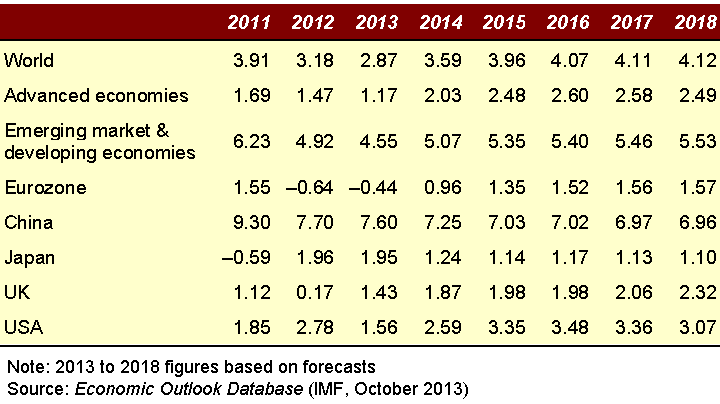 Chinese growth has slowed, as the government seeks to rebalance the economy away from exports and investment in manufacturing towards consumption, and services in particular. It is still forecast to be 7.3% in 2014, however – well above the global average. Japanese growth has picked up in response to the three arrows of fiscal, monetary and supply-side policy. But this could well fade somewhat as the stimulus slows. The table shows IMF growth forecasts for selected countries and groups of countries to 2018.
Chinese growth has slowed, as the government seeks to rebalance the economy away from exports and investment in manufacturing towards consumption, and services in particular. It is still forecast to be 7.3% in 2014, however – well above the global average. Japanese growth has picked up in response to the three arrows of fiscal, monetary and supply-side policy. But this could well fade somewhat as the stimulus slows. The table shows IMF growth forecasts for selected countries and groups of countries to 2018.
Much will depend on what happens to monetary policy around the world. How quickly will monetary stimulus taper in the USA and in Japan? Will the ECB introduce more aggressively expansionary monetary policy? When will the Bank of England start raising interest rates?
Growth within countries is generally favouring those on higher incomes, with the gap between rich and poor set to continue widening over the coming years. The pay of top earners has continued to rise considerably faster than prices, while increasingly flexible labour markets and squeezed welfare budgets have seen a fall in living standards of many on low incomes. According to a Which? survey (reported in the Independent article below), in the UK:
Only three in ten expect their family’s situation to improve in the new year, while 60% said they are already dreading the arrival of their winter energy bill. The Which? survey also found that 13 million people could afford to pay for Christmas only by borrowing, with more than four in ten using credit cards, loans or overdrafts to fund their festive spending. A third of people (34%) also dipped into their savings, taking an average of £450 from their accounts.
If recovery is based on borrowing, with real incomes falling, or rising only very slowly, household debt levels are likely to increase. This has been stoked in the UK by the ‘Help to Buy‘ scheme, which has encouraged people to take on more debt and has fuelled the current house price boom. This could prove damaging in the long term, as any decline in confidence could lead to a fall in consumer expenditure once more as people seek to reduce their debts.
 And what of the global banking system? Is it now sufficiently robust to weather a new crisis. Is borrowing growing too rapidly? Is bank lending becoming more reckless again? Are banks still too big to fail? Is China’s banking system sufficiently robust? These are questions considered in the articles below and, in particular, in the New York Times article by Gordon Brown, the former Prime Minister and Chancellor of the Exchequer.
And what of the global banking system? Is it now sufficiently robust to weather a new crisis. Is borrowing growing too rapidly? Is bank lending becoming more reckless again? Are banks still too big to fail? Is China’s banking system sufficiently robust? These are questions considered in the articles below and, in particular, in the New York Times article by Gordon Brown, the former Prime Minister and Chancellor of the Exchequer.
Articles
Global economy: hopes and fears for 2014The Observer, Heather Stewart and Larry Elliott (29/12/13)
Looking ahead to 2014 BBC News, Linda Yueh (20/12/13)
Low hopes for a happy new financial year in 2014 Independent, Paul Gallagher (29/12/13)
Brisk UK economic growth seen in 2014 fuelled by spending – Reuters poll Reuters, Andy Bruce (12/12/13)
GLobal Economy: 2014 promises faster growth, but no leap forward Reuters, Andy Bruce (29/12/13)
My 2014 Economic Briefing Huffington Post, Tony Dolphin (27/12/13)
Three UK Economy Stories that will Dominate in 2014 International Business Times, Shane Croucher (27/12/13)
Who You Calling a BRIC? Bloomberg, Jim O’Neill (12/11/13)
Hope and Hurdles in 2014 Project Syndicate, Pingfan Hong (27/12/13)
On top of the world again The Economist (18/11/13)
Digging deeper The Economist (31/10/13)
BCC Economic Forecast: growth is gathering momentum, but recovery is not secure British Chambers of Commerce (12/13)
Eight predictions for 2014 Market Watch, David Marsh (30/12/13)
Stumbling Toward the Next Crash New York Times, Gordon Brown (18/12/13)
Central banks must show leadership to rejuvenate global economy The Guardian, Larry Elliott (1/1/14)
Global economy set to grow faster in 2014, with less risk of sudden shocks The Guardian, Nouriel Roubini (31/12/13)
A dismal new year for the global economy The Guardian, Joseph Stiglitz (8/1/14)
Forecasts and reports
World Economic Outlook (WEO) IMF (October 2013)
Economic Outlook OECD (November 2013)
Output, prices and jobs The Economist
Bank of England Inflation Report: Overview Bank of England (November 2013)
Questions
- What reasons are there to be cheerful about the global economic prospects for 2014 and 2015?
- Who will gain the most from economic growth in the UK and why?
- Why is the eurozone likely to grow so slowly, if at all?
- Are we stumbling towards another banking crisis, and if so, which can be done about it?
- Why has unemployment fallen in the UK despite falling living standards for most people?
- What is meant by ‘hysteresis’ in the context of unemployment? Is there a problem of hysteresis at the current time and, if so, what can be done about it?
- Explain whether the MINT economies are likely to be a major source of global economic growth in the coming year?
- Why is it so difficult to forecast the rate of economic growth over the next 12 months, let alone over a longer time period?
The link below is to a podcast by Martin Wolf of the Financial Times. It considers a new book, Fault Lines by Raghu Rajan of the University of Chicago Booth School of Business. Rajan argues that the global economy is severely unbalanced:
There is a fair amount of consensus that the world economy is in need of rebalancing. Countries like Iceland, Greece, Spain, and the United States overspent prior to the crisis, financing the spending with government or private borrowing, while countries like Germany, Japan, and China supplied those countries goods even while financing their spending habits. Simply put, the consensus now requires U.S. households to save more and Chinese households to spend more in order to achieve the necessary rebalancing.
Martin Wolf identifies these imbalances and discusses various possible solutions. The problem is that what may seem sensible economically is not always feasible politically.
Podcast
 Three years and new fault lines threaten Financial Times podcasts, Martin Wolf (13/8/10)
Three years and new fault lines threaten Financial Times podcasts, Martin Wolf (13/8/10)
Article
Three years and new fault lines threaten (transcript of podcast) Financial Times podcasts, Martin Wolf (13/8/10)
Questions
- What are the fault lines that Martin Wolf identifies?
- Have they become more acute since the credit crunch and subsequent recession?
- What risks do these fault lines pose to the future health of the global economy?
- How do political relationships make integrating the world economy more difficult? What insights does game theory provide for understanding the tensions in these relationships?
- Is a policy of export-led growth a wise one for the UK to pursue?
- Explain why global demand may be structurally deficient.
 There is a lot of pessimism around about the state of the global economy and the prospects for more sustained growth. Stock markets have been turbulent; oil and other commodity prices have fallen; inflation has been below central bank targets in most countries; and growth has declined in many countries, most worryingly in China.
There is a lot of pessimism around about the state of the global economy and the prospects for more sustained growth. Stock markets have been turbulent; oil and other commodity prices have fallen; inflation has been below central bank targets in most countries; and growth has declined in many countries, most worryingly in China.